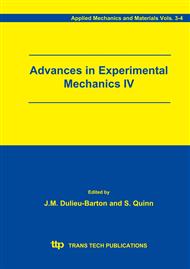p.59
p.65
p.71
p.79
p.85
p.91
p.99
p.105
p.111
FE Simulation of Laser Ultrasonic Surface Waves in a Biomaterial Model
Abstract:
This paper describes a study of laser generated ultrasonic waves in an 2-layer elastic, isotropic biomaterial model, in order to establish a modelling technique to simulate the thermoelastic response of high-power short pulse laser beams in human skin. The theory proposed in this paper takes into consideration the fundamental understanding of the laser/material interface. A finite element model using the commercial finite element code ANSYS is used to study the effects of laser pulse duration and energy flux contribution to the surface waves. The simulation comprises a set of boundary conditions that approximate a heat flux point source located on top of the surface of the material. Because of the time scale of interest, the elastic effects do not feed back into the thermal problems, so that a sequential coupled-field analysis was performed where the thermal and elastodynamic fields are uncoupled and treated separately. The initial finite element analysis involves a transient thermal analysis using a heat flux with Gaussian spatial variation to simulate the laser pulse heating. The results from the thermal analysis were read and applied to the structural analysis where the out-of-plane displacements histories are analyzed in the skin model with varying thicknesses
Info:
Periodical:
Pages:
85-90
Citation:
Online since:
August 2006
Authors:
Price:
Сopyright:
© 2005 Trans Tech Publications Ltd. All Rights Reserved
Share:
Citation:


